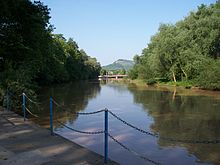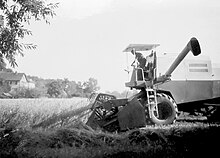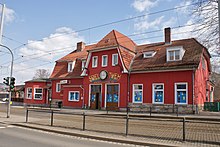Volkspark Oberaue
The Volkspark Oberaue in Jena is the only Thuringian park with the name Volkspark . The park consists of the three adjoining areas of the Rasenmühleninsel, Paradies and Oberaue. It has been classified as a cultural monument since 2002.
history
From the beginning to the Second World War
The Jenaer Oberaue - the part of the Saale floodplain upstream from Jena - was for centuries fertile meadows and arable land, which was supplied with nutrients by the Saale through regular floods. The part closest to the city has been called paradise since the Middle Ages . It is documented that at the time of the Principality of Saxony-Jena several trees were also planted in Paradise. The later Volkspark Oberaue emerged from paradise and the Wöllnitzer meadows to the right of the Saale .
First, in 1893, the construction of sports fields in the Wöllnitzer Wiesen began. Around 1910 there were already extensive sports facilities that belonged to various sports clubs (USV, VfB, 1. SV). The Ernst-Abbe-Sportfeld was built in 1922 as the last and largest facility in the early days . The Jena physician and honorary citizen Prof. Moritz Seidel (1836–1912) made a contribution to the establishment of the Volkspark. In his will, he bequeathed his fortune to the city of Jena with the obligation to “use the income to create a Volkspark and play areas for sports games to be used for all parts of the city's population ”. The Seidelstrasse and the “Seidelparkplatz” remind of him; At the beginning of the 20th century, the northern Oberaue was called Seidelpark.
From the Second World War to the end of the GDR
Parts of the Oberaue were used for growing vegetables after World War II in order to improve the supply in Jena. An expert report by Jena University from 1949, however, called for the entire Oberaue to be used as a leisure and recreation area and for other types of use to be gradually dismantled. In the 1950s, the Volkspark was created through voluntary or ordered work assignments from Jena schoolchildren and students as part of the national construction work (NAW), for which the city administration provided material, vehicles and equipment. Rubble from the city center, which was destroyed in World War II, was used to raise the level of the terrain. An open stage hall for open-air concerts and a boat rental were built near the Paradies-Café , built in 1937 , to the east of the Saale der Tierbrunnen (initially “Märchenbrunnen”) and the “Froschkönigin-Brunnen” as well as a home park in extension of the Jenertal street . The areas south of the Ernst-Abbe-Sportfeld, however, were used for agriculture until the 1970s.
The state-decreed development boost for Jena in the 1960s and 1970s resulted in the Volkspark, which was previously located away from the main traffic arteries, losing space, polluting the environment and converting some parts of it. The Stadtrodaer Strasse, opened in 1968, cut off the eastern area up to Wöllnitzer Strasse. From then on, traffic noise and car exhaust reduced the recreational value of the area east of the Saale; as a direct consequence, the zoo had to be abandoned. The children's and youth sports school with training hall was built in the area of the allotment garden division “Seidelpark”, which had to move to an area west of the Neuwöllnitz settlement . The last agricultural uses in the area have been given up for the new training areas of SC Motor Jena southeast and east of Schleichersee.
Around 1970, Paradise was largely destroyed for years, as the major construction site of the main sewer collector moved from Burgauer Weg to the Paradiesbrücke through the area; On the lawn mill island there was a concrete plant with large storage areas for the aggregates . The above-ground district heating pipeline, which was built there around the same time, remained a foreign body in the landscape for decades. The mill ditch of the lawn mill was filled in for the construction of the main collector and the heating line above it.
The damaged areas were only restored sparingly or not at all, like the fairground at the Paradies Café. However, in the 1970s, as part of a reconstruction project for the Rasenmühleninsel cultural park, the glass house , a bowling alley and a miniature golf course were built . The two Saale bridges east of the Rasenmühleninsel (the sports ground bridge from 1928 and a wooden makeshift bridge from the 1960s) were also replaced by a modern concrete bridge, but the dilapidated Südbadbrücke (a wooden bridge between Burgauer Weg and Südbad-Kassenhaus) was demolished without replacement. Circus performances on the meadow southeast of the animal fountain were added as a new use at this time , after the Gries in Jena-Ost was no longer available due to its conversion to a company site. For the arrival and departure of the large circuses common in the GDR , the path between Ernst-Abbe-Sportfeld and Tierbrunnen was specially paved. In 1988, the construction of this path in the direction of Wöllnitz began in order to create a car-free bicycle connection between the city center and Lobeda; In 1990 this was continuously passable. Incidentally, the Volkspark was run down in the 1980s and only rarely used; On the meadows east of the Saale, hay was extracted with large machines .
From the end of the GDR until today
From 1990 onwards, the Volkspark quickly revived thanks to the sharp increase in the number of students in Jena and the admission of cycling in Paradise; Until then, the existing cycling ban had been enforced by auxiliary police officers who were almost always present .
However, there were also several highly controversial attempts to downsize or partially abandon the park. The remaining free areas east of the Saale should be designated as building land, since they have been considered flood-free since the Saale dams were built. In April 1994, and several times since, they were almost completely flooded. The largely environmentally friendly tram on the eastern edge of the Oberaue was categorically rejected by environmental associations; to compensate, the rest of the alluvial forest "In der Grunzke" east of the Ernst Abbe sports field was placed under protection in 1995. Around 2000 tests were carried out to determine whether the construction of two motorways through the area (from Burgauer Weg through Paradies to Paradiesbrücke and from Puschkinplatz to Jenertal) could relieve the Knebelstrasse and Kahlaische Strasse; However, a poor environmental balance and high expenditure would have been disproportionate to the benefits of these projects. The park was immediately placed under protection.
In 2008, the city administration developed an extensive concept for upgrading the Volkspark and applied to host the Thuringian State Garden Show 2013, but was not taken into account. The measures planned in the concept will nevertheless be implemented over a longer period of time.
In 2020, a new driveway was built from Stadtrodaer Straße to the sports facilities in the southern part of the Volkspark, as required in the security concept for the Ernst-Abbe-Sportfeld to be converted. However, it should only be opened for risky games , while otherwise it is blocked by stable barriers.
The entire system
The dammed Saale flows through the Volkspark from south to north . There are two barrages, the lawn mill weir a little south of the comprehensive school UniverSaale and the paradise weir between the Paradies train station and the tram bridge. There are hydropower plants at both, the plant on the Paradies weir was put into operation in the spring of 2000.
The Saale divides the Volkspark into the smaller western part, in which the Paradies train station, the Paradies and the lawn mill island are located, and the larger eastern part with the actual Volkspark Oberaue, the sports facilities and the Schleichersee.
Crossings over the separating Saale are possible in four places: in the far north through the tram bridge and the Paradiesbrücke, at the southern end of the festival meadow through the sports ground and south of the Ernst-Abbe-Sportfeld through the Lichtenhain Saale bridge, built in 2012.
The Volkspark Oberaue
The park is bounded in the east by Stadtrodaer Straße (expressway between the city center and the motorway and the districts of Lobeda , Neulobeda and Burgau ). To the east of this street are the buildings of the Institute for Sport Science of the FSU Jena and the Gutsmuths Sportgymnasium Jena (school, boarding school, sports hall) as well as a conference hotel.
In the center and south of the park there are numerous sports facilities, in particular the Ernst-Abbe-Sportfeld , the Oberaue sports center and the Schleichersee , an artificial lake designed as an outdoor pool. Allotment gardens are even further south.
Several water sports clubs are domiciled above the lawn mill weir on both sides of the Saale . There are canoe docks and transfer options at the weirs. The Saale Cycle Path , the Thuringian City Chain Cycle Path and the Thuringian Mill Cycle Path continue to run on the same route through the Oberaue. The paths through the Oberaue are also important connections for inner-city cycling between the city center and the southern districts of Jena. For runners , routes over 3.4, 5.0 and 8.1 kilometers are marked; the 8.1 km route leads around the entire Oberaue to close to the districts of Burgau and Lobeda .
In the northeast of the park there is a popular meeting point around a historic fountain with animal figures (seal, turtle, snail, frog, bear and bird). This was destroyed by vandalism in the 1970s and reconstructed in 2005. In 2013 the new animal sculptures were also partially damaged and they were repaired again by spring 2013. Curt Unckel's monument is also in this park.
In the south-west of the park, a modern bridge was built over the Saale to the southern suburb in 2012, and a historic restaurant with beer garden was reconstructed and reopened.
In 2016 it was reported in local media that a pet cemetery is to be built in the immediate vicinity of the “animal fountain” in the Oberaue. Among other things, because in recent years more and more pets have been run over - due to the increasing volume of traffic on the adjacent Stadtrodaer Straße - a dignified final resting place for pets should be created there. The project manager explained that the grave could be designed individually. From a simple cardboard box to a true-to-original sculpture of the deceased animal, different variants are allowed. Individual sayings at the animal's grave are expressly desired. Flooding of the site in a flood situation should be avoided. However, a hydrological report has to be awaited.
The paradise
The actual paradise represents the smallest part of the entire complex. An essential component is an elongated meadow on which the three marble sculptures Atropos , Klotho and Lachesis have been located since April 2012 .
Railway tracks border the park in the west and north. In the northwest is the former train station building, which was used as a train station until 2005 and has since housed a game library and a restaurant. In the north is the new central train station Jena Paradies , which connects the city center with the Volkspark with its modern architecture. From the train station you can go over one of the two bridges over the Saale to Tierbrunnen or Stadtrodaer Straße. Large trees line the Saale in the west. A balcony built in 2010 allows an undisturbed view of the otherwise somewhat hidden hall. In the south, the tributary of the Leutra forms the border to the lawn mill island, where there is a small beach bar.
The lawn mill island
In the western part of the park, next to the railroad tracks and the former station building, there is the lawn mill island with a rectangular, approximately 300 m by 100 m large fairground. The name lawn mill island comes from the time of the lawn mill. Their mill ditch, which ran from the lawn mill weir to the confluence of the Leutra, cut off this area completely from the surrounding area with water. The lawn mill ditch ran in the area of today's heating route and swung back into the Saale shortly before the inflow of the Leutra.
The center of the lawnmill island is the fairground. Around these are sports, cultural and educational facilities that have been renovated or newly built since 2010:
- The Paradies-Café was renovated and reopened (2014–2015).
- A large children's playground was completely renovated (2014).
- The mini golf course was replaced by a slackline system (2014).
- The listed bowling alley was built over with seating and tables and the roof was renovated.
- The boggy water lily pond was dredged in 2013.
- The glass house in Paradise, which has been a listed building since 2002 (planned in 1974, built in 1978) was renovated (from 2010).
- The skate park was rebuilt (2012).
- A toilet facility was built (2012).
- The buildings of the municipal construction company that were destroyed by fire were cleared in 2012. The Free Comprehensive School UniverSaale and a small hotel were built in the same location in 2013. A former wild parking lot directly at the festival meadow was redesigned as a boules area and replaced by parking spaces in front of the school.
The large meadow was previously used for major events (Zeiss festivals, fairs, concerts), after the fall of the Wall there were open-air concerts with performances by German musicians Udo Lindenberg (September 5, 1990), Peter Maffay (May 20, 1992) and the Irish folklore group Kelly Family (May 28, 1995). Since the 1990s, when the weather is summery, the area has been used primarily by students as a lawn, barbecue area, meeting point or for recreational sports. Larger public events rarely take place there.
Saxon Marshes Nature Reserve
In the southern part of the park, between the Teufelslöchern and the Schleichersee, there is the small landscape protection area of Saxons marshes with alluvial-like trees and humid biotopes. At the beginning of the 1970s the area was divided by the expressway, sports facilities have further reduced it so that it now consists of three isolated sub-areas. It is currently used by a fishing club.
Cultural event
On December 2, 2011, a benefit concert entitled Rock 'n' Roll Arena Jena - For the colorful Republic of Germany as a sign of protest against right-wing extremism took place in the Oberaue (along Stadtrodaer Strasse behind the Tierbrunnen) after Jena was hit by the National Socialist Underground hit the headlines negatively. The patrons, Jena's Lord Mayor Albrecht Schröter , Prime Minister Christine Lieberknecht , SPD chairman Sigmar Gabriel and Jürgen Trittin , chairman of the Bundestag parliamentary group Bündnis 90 / Die Grünen , welcomed around 50,000 visitors. The artists were Udo Lindenberg , Julia Neigel , Toni Krahl , Clueso , the band Silly and Peter Maffay .
Web links
- History of the lawn mill on viaregia.org
- Saxon Marshes on viaregia.org ( Memento from October 6, 2014 in the Internet Archive )
Individual evidence
- ^ W. Lösch, R. Petzold, F. Reinhold, S. Wiegand: Jenaer streets and alleys . Tourist Office of the City of Jena, Jena, 1991. ISBN 3-910054-21-8 , p. 89
- ^ JH Schultze: Jena - Becoming, growth and development opportunities of the university and industrial city . VEB Gustav Fischer Verlag, Jena 1955, p. 105 .
- ↑ Heinz Voigt: Bar stories from Jena: Tingeltangel in Jenaer Paradies. Retrieved May 15, 2018 .
- ↑ Photo in: Henschel / Möller: Saalestadt Jena . VEB FA Brockhaus Verlag, Leipzig, 1964, p. 129
- ↑ Location can be seen in: Bergner: JENA. Turbulent times - the 50s and 60s . Wartberg Verlag, Gudensberg-Gleichen, 1996, ISBN 3-86134-346-0 , p. 71
- ↑ Dana Kurz: Veins of Jena: Site plan. Retrieved May 19, 2018 .
- ^ GLASHAUS im Paradies eV: Glashaus im Paradies: Structural and historical development of the glass house. Retrieved May 19, 2018 .
- ↑ last included in the city map of Jena with the editorial deadline August 16, 1979. VEB Tourist Verlag, Berlin / Leipzig, 1978
- ↑ Development concept for bicycle traffic Jena , Jena city administration, Department of Economy and Transport, April 1991, p. 9
- ^ Map in the environmental report of the city of Jena 1997 , Jena Environment and Nature Conservation Office, April 1997, p. 90/91
- ↑ ibid, pp. 22 and 24
- ↑ Final report on the Jena Transport Development Plan 2002 , City of Jena, Transport Planning and Civil Engineering Office, January 2003, pp. 116/117
- ↑ Saale paradise. Feasibility study for the implementation of the 3rd Thuringian State Garden Show 2013 in Jena , City of Jena, Urban Development Department, September 2008
- ↑ Jenaer Laufwege, route description. Retrieved July 8, 2018 .
- ↑ Thomas Beier: Vandalism in the Jena Oberaue - the animal fountain has been hit. Thüringische Landeszeitung , January 9, 2013, accessed on April 21, 2013 .
- ↑ Waldemar wink: Jena plans pet cemetery in the Oberaue. April 1, 2016, accessed September 15, 2017 .
- ↑ Concert in Jena: 50,000 rock against the right. Spiegel Online , December 3, 2011, accessed April 21, 2013 .
Coordinates: 50 ° 55 ′ 20 ″ N , 11 ° 35 ′ 10 ″ E



















